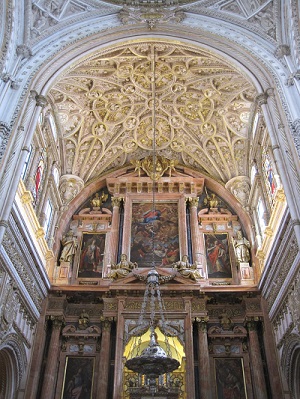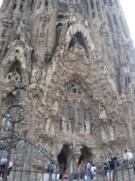The Fountainhead, part 2, chapter 12
Roark finishes building his Temple of the Human Spirit just in time for his patron, Hopton Stoddard, to return from a round-the-world tour of famous religious sites. The night before the official unveiling, Stoddard comes to see the temple for himself – ominously, accompanied by Ellsworth Toohey. (*dramatic chord – dun dun DUN*)
The next day, Stoddard announces in a terse public statement that the opening has been postponed indefinitely. The day after that, Toohey publishes a column in the New York Banner titled “Sacrilege”:
“Howard Roark — as most of you have not heard and are not likely to hear again — is an architect. A year ago he was entrusted with an assignment of extraordinary responsibility. He was commissioned to erect a great monument in the absence of the owner who believed in him and gave him complete freedom of action. If the terminology of our criminal law could be applied to the realm of art, we would have to say that what Mr. Roark delivered constitutes the equivalent of spiritual embezzlement.”
The day after that, Stoddard files a lawsuit against Howard Roark, alleging breach of contract. He demands damages, a sum of money “sufficient to have the Temple altered by another architect”. (*dun dun DUN*)
Yes, that’s right. We’re about to get that classic Randian plot device, the Dramatic Courtroom Scene. In fact, she liked them so much that The Fountainhead has not one but two Dramatic Courtroom Scenes. It’s twice as many long-winded speeches for your dollar!
As a prelude to the trial, Toohey explains in his newspaper column what makes Roark’s temple so offensive:
“It seems as if a deliberate malice had reversed in this building every conception proper to a religious structure. Instead of being austerely enclosed, this alleged temple is wide open, like a western saloon. Instead of a mood of deferential sorrow, befitting a place where one contemplates eternity and realizes the insignificance of man, this building has a quality of loose, orgiastic elation. Instead of the soaring lines reaching for heaven, demanded by the very nature of a temple, as a symbol of man’s quest for something higher than his little ego, this building is flauntingly horizontal, its belly in the mud, thus declaring its allegiance to the carnal, glorifying the gross pleasures of the flesh above those of the spirit. The statue of a nude female in a place where men come to be uplifted speaks for itself and requires no further comment.”
Well, that doesn’t sound so bad to me. They can always rent it to the Unitarian Universalists.
Because architecture is Serious Business in the world of The Fountainhead, Toohey’s column incites a wave of popular anger against Roark:
The clamor of indignation that rose against Howard Roark and his temple astonished everyone, except Ellsworth Toohey. Ministers damned the building in sermons. Women’s clubs passed resolutions of protest. A Committee of Mothers made page eight of the newspapers, with a petition that shrieked something about the protection of their children… The A.G.A. issued a dignified statement denouncing the Stoddard Temple as a spiritual and artistic fraud.
To be fair, Rand says that “Nobody would have felt an urge to crusade about a building; but religion had been attacked” and Roark makes a convenient villain for the press to bash. But has religion been attacked, really?
Michaelangelo’s David (or, for that matter, the Creation Museum’s Adam and Eve) aren’t generally seen as attacks on religion just because they’re naked, plus or minus some artfully placed fig leaves. Small rural churches and temples may be simple one-story affairs that can’t afford “soaring lines reaching for heaven”, but they’re not angrily rejected by worshippers.
The kind of sacred architecture that Toohey is referring to, with soaring ceilings, frowning saints, and gruesome depictions of hell, is a Western, a medieval, and, arguably, a Roman Catholic conception of what a religious building should look like. I’ve always had a soft spot for ornate cathedrals, not for their religious message but for the grandeur of their design and the amount of human labor and dedication that went into constructing them. But it’s just not true to say that it’s the only way people have ever tried to represent the supernatural in architecture.
Hindu temple architecture, for example, is enormously variable. Some styles have a multi-story sanctum, others are single-story. Some types have spires and towers, others don’t. However, one of the most common motifs is a geometric grid of concentric squares: “The square is considered divine for its perfection and as a symbolic product of knowledge and human thought.” Sounds almost Objectivist to me!
Jewish synagogues also don’t have a specific style of their own, but tend to mirror the architectural styles that are most common in the times and places they’re built: “Thus there were Neoclassical, Neo-Byzantine, Romanesque Revival, Moorish Revival, Gothic Revival, and Greek Revival. There are Egyptian Revival synagogues and even one Mayan Revival synagogue.”
Buddhist viharas, the traditional halls and living quarters for monks, often aren’t especially vertical. They don’t have “soaring lines reaching for heaven”, which is to be expected since heaven isn’t really a thing in most kinds of Buddhism. Worse, from Toohey’s standpoint, many of them are wide-open, “saloon”-like structures designed around a shared space or courtyard.
The same is true of Islam. Nearly all Islamic mosques have a sehan, a large central courtyard open to the sky, surrounded by columned arcades. Other common features include intricately carved arabesques, colorful mosaics, and paradise gardens – all of which seem intended to produce a mood more like elation than “deferential sorrow”.
Although most of them were built after The Fountainhead was published, there are also churches designed in modernist styles: sparse decoration, geometric or natural patterns, concrete and steel rather than stained glass. I especially like some of the Icelandic ones. Although the Catholic church can get grumpy about them, they haven’t been greeted with the mass outrage this book would lead one to expect.
 |
 |
 |
 |
 |
 |
Are all these examples of religious architecture intended to create the same feelings in worshippers? From top, left to right: The Great Mosque of Córdoba, Spain; the Cathedral of Córdoba, a later Christian addition to the same site; arabesques at the Alhambra, Grenada, Spain; the Sagrada Família, Barcelona, Spain; the Touro Synagogue, Newport, Rhode Island; Hallgrímskirkja, Reykjavik, Iceland. Click to see larger versions. All photos by the author.
Obviously, Toohey isn’t trying to be fair to Roark, so it wouldn’t serve his purpose to mention these things. Still, he’s not the only expert on architecture in the world. There’s no real reason, other than authorial decree, why public opinion should be so instantly and unanimously against Roark – let alone for a building that almost no one else has seen!
Making it worse, the handful of people who take Roark’s side decide to do nothing in his defense:
[Toohey] made Stoddard open the Temple to the public while awaiting the trial of his suit. The Temple attracted crowds of people who left obscene drawings and inscriptions on the pedestal of Dominique’s statue.
There were a few who came, and saw, and admired the building in silence. But they were the kind who do not take part in public issues.
In the world of The Fountainhead, true Objectivists seem averse to sharing their opinions with the world. It’s strange, considering that “unwilling to say what was on her mind” is one thing you could never accuse Ayn Rand of.
Meanwhile, Roark is preparing for the trial:
Roark refused to hire an attorney to represent him at the coming trial. He said he would handle his own defense and refused to explain how he intended to handle it, in spite of Austen Heller’s angry protests.
“Austen, there are some rules I’m perfectly willing to obey. I’m willing to wear the kind of clothes everybody wears, to eat the same food and use the same subways. But there are some things which I can’t do their way — and this is one of them.”
Let no one say that Howard Roark lacks the common touch. Why, he even wears clothes and eats food, just like the rest of us. What a man of the people!
“What do you know about courtrooms and law? He’s going to win.”
… “Is the case of any importance? There’s nothing I can do to stop him from touching the building. He owns it. He can blast it off the face of the earth or make a glue factory out of it. He can do it whether I win that suit or lose it.”
“But he’ll take your money to do it with.”
“Yes. He might take my money.”
This raises an interesting question: Why doesn’t Roark care what clients do with his buildings?
We know he’s absolutely unwilling to compromise at the design stage, to the point of walking away if a client insists on even a trivial change to his sketches. It’s downright odd that, as soon as construction is done, he no longer cares if they want to tear the building down or stick on a new facade or put gold leaf and pink flamingos on it. Why doesn’t he write a line into his contract like, “The client agrees not to alter or remodel the building for a minimum of five years,” or something like that?
Other posts in this series: